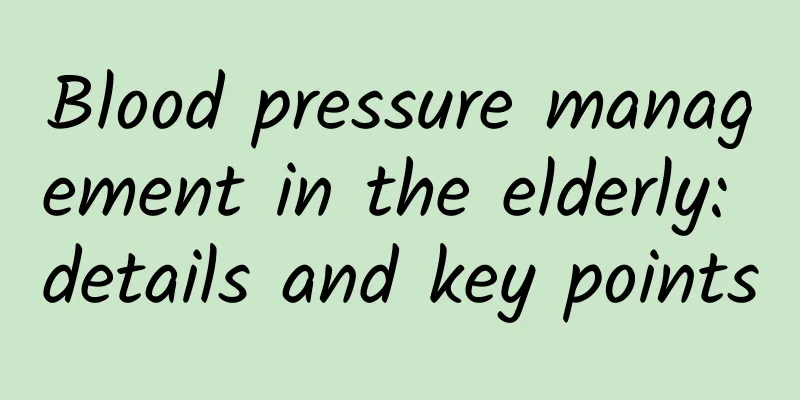Blood pressure management in the elderly: details and key points

|
As people age, their physical functions decline and their risk of developing high blood pressure increases. Blood pressure management is of great significance to the health of the elderly and can significantly reduce the risk of serious complications such as heart disease and stroke. 1. Characteristics of blood pressure in the elderly High systolic blood pressure and large pulse pressure difference: Elderly people have arteriosclerosis, reduced vascular elasticity and increased stiffness. When the heart contracts, the blood vessels are difficult to effectively expand and buffer, resulting in increased systolic blood pressure; when the heart relaxes, the vascular retraction force weakens, the diastolic blood pressure decreases, and the pulse pressure difference increases. For example, a 70-year-old may have a blood pressure of 160/70 mmHg and a pulse pressure difference of 90 mmHg. Large fluctuations in blood pressure: The regulation function of pressure receptors in the elderly is impaired, and blood pressure is easily affected by many factors. Seasonal changes cause blood vessels to contract in winter and blood pressure to rise; blood vessels to dilate in summer and blood pressure to fall. In addition, mood swings and changes in body position (such as standing up suddenly) can also cause large fluctuations in blood pressure. Most cases of hidden hypertension: Some elderly people have normal blood pressure when measured in the clinic, but their blood pressure increases when they self-measure at home or use dynamic blood pressure monitoring, which is called hidden hypertension. This is related to factors such as the elderly's daily activities and mental state. Failure to detect and treat it in time increases the risk of cardiovascular disease. 2. Blood Pressure Management Goals Generally speaking, for the elderly aged 65-79, blood pressure should be reduced to below 150/90 mmHg. If tolerated, it can be further reduced to 140/90 mmHg. For the elderly aged 80 and above, it is more appropriate to control systolic blood pressure at 150-160 mmHg. However, the specific target needs to be determined by the doctor based on the individual's health status and whether there are complications. For example, for the elderly with diabetes or chronic kidney disease, the blood pressure control target may be more stringent. 3. Lifestyle Intervention Diet adjustment: Strictly limit salt intake, with daily salt intake not exceeding 5 grams, and reduce the intake of pickled foods and processed snacks. Increase potassium intake, eat more fruits and vegetables such as bananas, potatoes, and spinach to promote sodium excretion. At the same time, control fat intake, eat less animal offal and fried foods, and increase unsaturated fatty acid intake, such as olive oil and deep-sea fish. Moderate exercise: Choose slow-paced, moderate-intensity exercise, such as walking, Tai Chi, and Ba Duan Jin. Do at least 150 minutes of moderate-intensity aerobic exercise per week, such as brisk walking, with a speed of 100-120 steps per minute; or 75 minutes of high-intensity aerobic exercise, such as jogging. Exercise should be gradual, and warm up and relax before and after exercise. Quit smoking and limit alcohol consumption: Smoking can damage the endothelium of blood vessels and increase blood pressure. Elderly people must quit smoking. Excessive drinking can also cause blood pressure to rise. It is recommended that men should not consume more than 25 grams of alcohol per day, and women should reduce it by half. Regular work and rest and emotional regulation: Maintain a regular work and rest schedule and ensure 7-8 hours of adequate sleep. Emotional fluctuations can cause unstable blood pressure. The elderly should learn to regulate their emotions and relax by listening to music, playing chess, etc. IV. Precautions for drug treatment Starting with a low dose: Elderly people have reduced liver and kidney function, which reduces their ability to metabolize and excrete drugs, making them more susceptible to adverse drug reactions. Therefore, drug treatment should start with a low dose. For example, when using antihypertensive drugs for the first time, use half of the regular dose and gradually adjust the dose according to blood pressure and tolerance. Choose the right medicine: Long-acting antihypertensive drugs are preferred, which can steadily control blood pressure, reduce blood pressure fluctuations, and improve medication compliance. For example, amlodipine can be taken once a day. Elderly people with prostatic hyperplasia can choose α-receptor blockers such as terazosin, which can both lower blood pressure and improve urination symptoms. Pay attention to adverse reactions: Pay close attention to adverse drug reactions during medication. Using diuretics may cause hypokalemia, fatigue, and arrhythmia; beta-blockers may affect heart rate and cardiac conduction, leading to bradycardia. If you feel unwell, inform your doctor in time to adjust the medication. 5. Key points of blood pressure monitoring Regular measurement: The elderly should measure their blood pressure regularly. They can measure it at home once in the morning and evening, 2-3 times each time, and take the average value. After the blood pressure stabilizes, it can be measured 2-3 days a week. Go to the hospital for regular measurement and communicate with the doctor about the blood pressure control situation. Measurement in special circumstances: If you experience dizziness, headache, palpitations, or other discomfort, or after adjusting the dosage of medication, measure your blood pressure in a timely manner and record the value for your doctor's reference. When measuring, pay attention to the correct posture and use a suitable cuff to ensure accurate measurement. |
>>: Vertical lines and white spots on the nails are a "sign of death"? 4 conditions to be alert to →
Recommend
Health products can cure all diseases and can be taken as medicine? It’s not too late to know the truth now
gossip "Health supplements can treat many di...
Why is white coffee called white coffee? Is white coffee high in calories?
White coffee has a smooth and pure taste, and its...
What are the causes of small bumps in women's vagina?
Gynecological diseases in women are very common i...
Why is there brown discharge after menstruation?
Many women become worried when they discover brow...
What kind of fish is Qingjiang fish used in grilled fish? Can carp be used for grilled fish?
During the late Qing Dynasty, a smart woman emerg...
What will it be like to swim during your period?
Swimming has many benefits to the body. It can st...
What to do if you don't have enough milk 20 days after giving birth
Pregnant women will experience breast pain, which...
How to drink white peony tea to lose weight? What should you pay attention to when drinking white peony tea to lose weight?
Drinking tea is a good way to get rid of greasine...
If pregnant women eat bayberry, will the fetus become dark?
Bayberry wine is a common fruit in daily life. It...
Love has a “shelf life”, so does myopia surgery also have a “shelf life”?
I believe that most people have this simple and p...
There is a little suppuration at the cesarean section line
Cesarean section has certain sequelae and side ef...
What does bad cervical condition mean?
When a woman is giving birth, the doctor often ne...
Treatment of lochia after miscarriage
A woman will go through the process of pregnancy ...
How much does cervical repair surgery cost?
Cervical erosion is also a very common gynecologi...
Maintenance methods after subtotal hysterectomy
The female body structure is very complex, and th...









